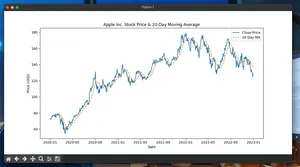Overview
Use Python to compute key algorithmic trading metrics (CAGR, Sharpe, drawdown) and publish both raw PnL and summaries to Google Sheets. This guide shows a minimal working example and practical tips for reliable, fast updates.
What you’ll build:
- A Python script that generates or ingests strategy returns
- A metrics summary sheet and a PnL sheet in Google Sheets
- Efficient bulk writes and optional sharing
Quickstart
- Install packages
- pip install pandas numpy gspread google-auth
- Create a service account and key
- In your Google Cloud project, create a service account and a JSON key file
- Save the file locally (e.g., service_account.json)
- Enable API scopes in code
- Use spreadsheets and drive scopes to create and edit sheets
- Choose how to access a spreadsheet
- Easiest: let the script create a new spreadsheet the service account owns
- Or: create a Google Sheet manually and share it with the service account email
- Run the script
- The script writes PnL and metrics, prints the spreadsheet URL, and optionally shares it if GSHEETS_SHARE_WITH is set
Data model in Sheets
- PnL worksheet: Date, Return, Equity
- Summary worksheet: key metrics as name-value pairs
Minimal Working Example (Python)
import os
import numpy as np
import pandas as pd
import gspread
from math import sqrt
from google.oauth2.service_account import Credentials
# Config
SCOPES = [
"https://www.googleapis.com/auth/spreadsheets",
"https://www.googleapis.com/auth/drive",
]
SERVICE_ACCOUNT_FILE = "service_account.json" # Path to your JSON key
SHARE_WITH = os.getenv("GSHEETS_SHARE_WITH") # Optional: email to share the sheet with
# 1) Authenticate
creds = Credentials.from_service_account_file(SERVICE_ACCOUNT_FILE, scopes=SCOPES)
client = gspread.authorize(creds)
# 2) Create spreadsheet (service account will own it)
sh = client.create(pd.Timestamp.utcnow().strftime("Algo Results %Y%m%dT%H%M%SZ"))
# Optional: share so your user account can see it in Drive
if SHARE_WITH:
sh.share(SHARE_WITH, perm_type="user", role="writer")
# 3) Prepare worksheets
# Remove default sheet for cleanliness and add two named sheets
try:
sh.del_worksheet(sh.sheet1)
except Exception:
pass
ws_pnl = sh.add_worksheet(title="PnL", rows=2000, cols=10)
ws_summary = sh.add_worksheet(title="Summary", rows=50, cols=4)
# 4) Generate example daily returns (replace with your strategy output)
np.random.seed(42)
periods = 252 # ~1 trading year
mu, sigma = 0.0005, 0.01
returns = pd.Series(np.random.normal(mu, sigma, periods),
index=pd.bdate_range("2024-01-01", periods=periods))
def compute_metrics(returns: pd.Series, rf=0.0, periods_per_year=252):
returns = returns.dropna()
n = len(returns)
equity = (1 + returns).cumprod()
total_return = equity.iloc[-1] - 1.0
cagr = (1 + total_return) ** (periods_per_year / n) - 1.0 if n > 0 else np.nan
vol = returns.std() * sqrt(periods_per_year)
sharpe = ((returns.mean() * periods_per_year) - rf) / vol if vol > 0 else np.nan
downside = returns[returns < 0].std() * sqrt(periods_per_year)
sortino = ((returns.mean() * periods_per_year) - rf) / downside if downside > 0 else np.nan
rolling_max = equity.cummax()
drawdown = equity / rolling_max - 1.0
max_dd = drawdown.min() if not drawdown.empty else np.nan
win_rate = (returns > 0).mean()
avg_win = returns[returns > 0].mean()
avg_loss = returns[returns < 0].mean()
return {
"Observations": n,
"Total Return": total_return,
"CAGR": cagr,
"Volatility": vol,
"Sharpe": sharpe,
"Sortino": sortino,
"Max Drawdown": max_dd,
"Win Rate": win_rate,
"Avg Win": avg_win,
"Avg Loss": avg_loss,
"Final Equity": float(equity.iloc[-1]) if n else np.nan,
}, equity
metrics, equity_curve = compute_metrics(returns)
# 5) Write PnL table in one bulk update
pnl_values = [["Date", "Return", "Equity"]]
for dt, r in returns.items():
pnl_values.append([dt.strftime("%Y-%m-%d"), float(r), float((1 + returns.loc[:dt]).prod())])
ws_pnl.update("A1", pnl_values, value_input_option="RAW")
# 6) Write Summary as name-value pairs
summary_values = [["Metric", "Value"]]
for k, v in metrics.items():
summary_values.append([k, float(v) if pd.notna(v) else ""])
ws_summary.update("A1", summary_values, value_input_option="RAW")
print("Spreadsheet URL:", sh.url)
Notes:
- Replace the synthetic returns with your backtest/live PnL
- For live runs, append the latest row to PnL and recompute metrics
Updating With Live Results (incremental)
- Append new rows with worksheet.append_rows([[date, return, equity]])
- Recompute metrics on appended data; write only the Summary block
- Consider a “Latest” sheet for current status to avoid rewriting large ranges
Example append snippet:
# Assuming ws_pnl already references your PnL worksheet
from datetime import datetime
new_dt = datetime.utcnow().strftime("%Y-%m-%d")
new_ret = 0.002
# Compute new equity by reading just the last equity value
last_equity = float(ws_pnl.get("C2:C")[0][-1]) if ws_pnl.row_count > 1 else 1.0
new_equity = last_equity * (1 + new_ret)
ws_pnl.append_rows([[new_dt, new_ret, new_equity]], value_input_option="RAW")
Recommended layout
- PnL: raw daily or per-trade results
- Summary: compact metrics for dashboards and chart data sources
- Optional sheets:
- Params: strategy parameters and versions
- Trades: per-trade details if needed (separate from daily PnL)
Pitfalls and gotchas
- Auth/permissions: if you create a sheet with the service account, share it to your user email to see it in Drive
- Quotas: avoid per-cell updates; batch writes to rectangular ranges
- Timezones: standardize to UTC; store timestamps as ISO-8601 strings
- Numeric formats: Sheets may auto-format; write RAW and format in UI if needed
- Series gaps: NaNs break cumulative equity; forward-fill or drop as appropriate
- Date order: ensure ascending dates before cumulative calculations
- Large sheets: keep PnL lean; archive old rows to a second sheet
- Secrets: do not commit service_account.json; use environment variables and .gitignore
Performance notes
- Prefer ws.update("A1", values) with a 2D list over cell-by-cell updates
- Group multiple ranges with sh.batch_update for fewer round-trips
- Append only new rows for live runs; avoid rewriting the entire PnL
- Precompute metrics in Python; send only compact outputs to Sheets
- Cache: keep the last equity locally to compute incremental updates
- Network resilience: add retries with exponential backoff on 429/5xx
Tiny FAQ
Q: Do I need a Google Cloud project? A: Yes. Create a service account with a JSON key and enable Sheets/Drive.
Q: Can I write a pandas DataFrame directly? A: Convert to a 2D list with df.itertuples or df.values.tolist and use ws.update. Optional helpers exist but aren’t required.
Q: How do I stream live results safely? A: Buffer updates (e.g., every N trades or minutes), append in batches, and recompute summary. Respect API quotas.
Q: How do I control formats? A: Write RAW values and adjust formats in the Sheets UI or via batch_update with formatting requests if needed.
Q: Where should I compute metrics? A: In Python for speed and reproducibility. Use Sheets mainly for visualization and sharing.
Next steps
- Replace synthetic returns with your backtest/live outputs
- Add a Trades sheet and compute per-trade stats
- Build charts in Sheets referencing PnL and Summary





